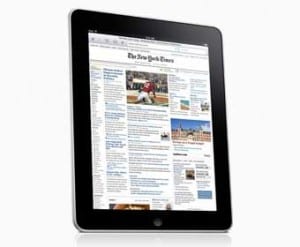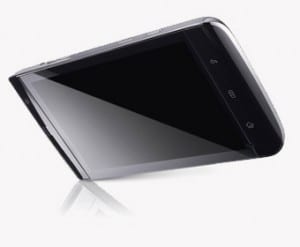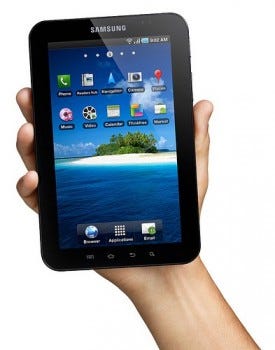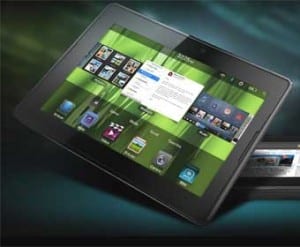Checking out the formChecking out the form
The tablet form factor hit the big time in 2010, fuelled by the now familiar hype that accompanied the launch of apple’s ipad. taking the full touchscreen smartphone to a larger size, the tablet might be interpreted as proof of that design concept’s superiority. But the hard keyboard refuses to die and attempts to create new product niches, such as ‘smartbooks’, mean that the form factor debate in the high end mobile internet device segment is far from settled.
November 17, 2010

The tablet form factor hit the big time in 2010, fuelled by the now familiar hype that accompanied the launch of apple’s ipad. Taking the full touchscreen smartphone to a larger size, the tablet might be interpreted as proof of that design concept’s superiority. But the hard keyboard refuses to die and attempts to create new product niches, such as ‘smartbooks’, mean that the form factor debate in the high end mobile internet device segment is far from settled.
US terminal vendor Motorola introduced its famous RAZR clamshell handset in late 2004. The phone, svelte and sophisticated as it appeared, achieved enormous popularity, with Motorola selling more than 110 million units over the product’s four year run. In some ways (and outside of markets like Japan, where the clamshell is overwhelmingly popular as a design) the RAZR represented the peak of the clamshell, a form factor which variously drew comparisons with the masculine technological thrusts of science fiction and the dainty femininity of the powder compact. The problem for the clamshell was that it was ill-suited to the evolution of the mobile device towards a greater range of applications. Since the birth of the mobile phone until the peak of the RAZR, the handset industry’s leading design minds had been obsessed with making everything as small as possible. But as the improvements in interface technologies, network performance and processing power came into alignment, miniaturisation took a back seat to functionality, and the clamshell lost its lustre. Today, among the highest end smartphones, one physical design is overwhelmingly prevalent. A touch screen fills the front of the handset, with very few or no hard keys included.
There are variations, of course, but look at the iPhone, look at all of the Android smartphones that have been released and look at the top end handsets based on vendors’ proprietary platforms (such as Samsung’s Bada) and it is clear that the differences between their physical designs are negligible. While Apple deserves recognition for kick-starting the recent burst of enthusiasm for this format, the format itself is nothing new. An evolution of the PDA, attempts at crossover devices—based on the format but hampered by limitations in technology and interface design—have been around for years. Apple made a success of the format by making it easier and more rewarding to use. The fact that so many vendors have now gathered around this particular design of terminal illustrates a key fact of industry life: handset vendors, by and large, are inherently conservative. It’s not unduly harsh that the devices rushed to market in the wake of the iPhone were often described as ‘copycat’, ‘me-too’ or ‘iPhone imitators’. Post the iPhone launch, it was simply not seen as sensible business among vendors to deviate from a model that had proven popular among users to the point of cultism and obsession—and one that seemed to tick the most boxes in terms of usability.
If one were inclined to doubt it, Apple proved the rule again with the launch of the iPad earlier this year (see box). It is also true, though, that the popularity of handset form factors moves in cycles, often dependent on the quality and popularity of the products that leads the market. For a time, Nokia’s candybar format was copied by all. That the Finnish firm refused for so many years to be dragged into the clamshell space perhaps represented the first indications of an intransigence that would cause it problems down the line. Times moved on and Nokia’s struggles today, particularly in the high end handset market, are well documented. And yet it still insists on a commitment to its favoured formats, bucking the trends of market direction—about which, more later. If these things move in cycles, then there are two obvious questions: When will the current cycle end, and what will come next? Ian Hutton, who is roadmap manager in the Technology team at the Symbian Foundation, believes that, whatever it is that’s coming, it is imminent—and that the end of the iPhone-style design as the format of choice is nigh.
“There are periods when one device or form factor is very successful so all the vendors focus on it, which then starts to starve consumers of choice,” Hutton says. “At some point one of the vendors will take a risk and try something a little different. My gut feeling is that we’re currently nearing the end of the cycle for these ‘glass slab’ type of handsets because a lot of the OEMs are struggling to differentiate their products from a glut of similar devices on the market,” he says. Vendors’ inclination to move as a herd in terms of handset design has been exaggerated by the economic downturn. In times of constraint, the safe bet for investment dollars becomes even more appealing. One element of the ‘glass slab’ design that looks set to remain irrespective of the design cycle is the touch screen, says Roberto di Pietro, vice president for product marketing and business development at Qualcomm CDMA Technologies, whose Snapdragon processor has won popularity among developers of Android smartphones. “
The touch screen will remain one of the key elements of various smartphone form factors,” di Pietro says. “The reason is this dramatic increase in interaction between the user and the screen itself.” Even in handsets that buck the trend for the familiar all-touch interface devices of today, some form of touch screen will seemingly always be necessary in the high end. Which brings us back to Nokia and its refusal to be drawn fully into the crowd. Nokia’s recently announced flagship product, the E7, is the latest attempt to combine the display benefits and interactive convenience of the full touch screen with a functioning hard keyboard. The text input solution on the iPhone, and on many full-touchscreen handsets, has often been identified as a weakness.
The Symbian Foundation’s Ian Hutton, who of course has a vested interest in the success of the E7, as it is one of four Nokia handsets that constitute the entire portfolio of product based on Symbian ^3, argues that the QWERTY keyboard still has an important role to play in the smartphone space. “It’s a proven form factor that has fallen away a little bit while every vendor has gone down the glass slab route,” he says. “But it’s very valuable for a fair set of users—and not just the business users that it’s been aimed at in the past. It’s now also being targeted at people who use social networks a lot, or bloggers; anybody who is doing a fair bit of text or data entry. It’s likely to be a form factor that stays with us for good,” he says.
Hutton highlights the importance of use case in choice of form factor. Full-touchscreen smartphones are designed primarily as consumption devices, excelling at web browsing, video viewing and applications like mapping. Keyboards, as he says, have historically been associated with enterprise level applications like Research In Motion’s Blackberry email service. The problem has been that devices featuring a keyboard require compromise in terms of size; whether it’s the size of the screen, as with Blackberry devices, or the size of the unit overall, as with the E7. And size is an issue. Despite the tolerance for larger devices that has always existed at the highest tier of the handset market, there are limits to how large a device required to function as a telephone can get, and there are debates as to what those limits are. James Bruce is Wireless Segment manager at ARM, the UK silicon vendor that has product in more than 95 per cent of smartphones currently in the market. “With smartphones one of the biggest limitations is the physical size of people’s pockets,” Bruce says. “So the physical limit on the screen at the moment is going to be from four inches to 4.2 inches. Anything larger and it won’t slip into people’s pockets.”
But Qualcomm’s Roberto di Pietro believes that a device with a five-inch screen—which is the size of the screen on the Dell Streak tablet—could still be sold as a smartphone. In any case, he predicts, a move to multi-screen architecture is inevitable. “Even in smartphones, we see a wider use of multiple displays,” he says. “You can have two or three hi-res displays, or in some cases a hi-res display and a standard display which you use as a touch screen to control the main display. This is definitely something that is going to happen in the medium term.”
All of which will place substantial demands on a device’s battery life, the greatest limiting factor on the design ambitions of handset vendors. Developments in battery technology are generally slower than developments other key components—displays, storage, processing power—which restricts the evolution of devices, especially in key areas like the kind of multi-display architectures that di Pietro prophesies. There are developments that could offset the drag produced by battery evolution, however. Arm’s James Bruce says that dual core processors, where the separate cores can be switched on or off depending on the activity for which the handset is being used at any given time will generate dramatic improvements in the efficiency of devices. Qualcomm, meanwhile, has high hopes for its Mirasol display line, which uses biomimetic technology to create low power, bright displays that harness reflected light. The technology is based on the same principle that causes butterflies’ wings to shimmer.
While these displays are still in development, the expectation is that they will enable an environment in which the device screen never needs to power down, as they are today programmed to do in order to conserve battery life. Power consumption is far less of an issue in larger devices like netbooks and laptops, which can accommodate more substantial battery packs. And as smartphone functionality has improved to the point of encroachment on the traditional portable computer’s territory, the lines between types of device are starting to blur. This is something that some organisations are actively seeking to encourage, among them Qualcomm, which is pushing the concept of a breed of device it calls the ‘smartbook’. These devices should be seen in terms of pushing the value and user experience of the smartphone upwards into larger devices, rather than creating another range of “defeaturised laptops”, according to Roberto di Pietro. But not everybody believes that slicing the market into such wafer-thin segments is a viable proposition.
“I struggle to see a clear market niche for these smartbook devices,” says Chris Goswami, director of product management at Openwave. “I think people either want something they can put into their pocket, which makes them truly mobile, or they want something they can put in their laptop bag, which is portable. This continued segmentation of the space in between, to try and create more and more niches, I just don’t see the use cases,” he says. The limitations on form factor are not just physical, however. Thanks to Apple, the success of the smartphone is closely tied to the application ecosystem; without a healthy third party community of developers, the smartphone is just a hi-tech shell. But developers have to follow the money and any vendor looking to shake up the form factor of its smartphone portfolio would have to be confident of developer support.
“As a vendor you might well want to innovate, and launch an amazing new phone in an amazing new form factor,” says the Symbian Foundation’s Ian Hutton. “But if no existing software works on that phone, and every developer is going to have to rewrite their applications specifically for that phone, that causes you big problems from a number of perspectives.” With this in mind, it is perhaps easier to understand the similarities between the smartphones put out by competing vendors. Perhaps Ian Hutton is right, and the end of the ‘glass slab’ form factor is just around the corner. But the nascence of the tablet business might suggest that this format of device, whether it is tablet sized or handset sized, has a few years to run yet. Apple’s success with the iPhone was using the hardware to showcase the end to end product, so it wasn’t exclusively an issue of form factor. The next game changing innovation may be more closely linked to industrial design.
There is much talk of foldable displays at the moment, a development that could address the conflict between portability and functionality in a way that has yet to be seen. Such technology remains the stuff of the future but, when you consider that the RAZR debuted in 2004, which is the recent past by almost any measure, the next revolution in smartphone design could be here before we know it.
Spot the difference
Tablet computers have been around for years but, prior to 2010, they failed to capture the imagination of the computing public. Largely restricted to a number of specialist use cases, the tablet’s arrival in the spotlight, and subsequent desirability, came to pass this year. And it was thanks, largely, to Apple.
Amid the kind of Hype that Steve Jobs’ firm is now alone in being able to generate, the Apple iPad launched in April this year, generating a wave of enthusiasm for the format, and the inevitable appearance of imitators. The approach to Christmas is likely to see contributions from even more vendors but, at the close of September, there are four leading contenders in the connected tablet space. Here’s how it happened:

ipad
April 2010
Apple unveils the iPad on April 3rd, with Steve Jobs claiming it was conceived as a product before the phenomenally successful iPhone which put Apple on the telecoms map. Like the first iteration of the iPhone, the device is notable for the limitations of its connectivity, with a wifi-only unit making the product’s debut. A version with 3G cellular connectivity arrives shortly down the line, but carries a significant price premium. Apple sells 300,000 units in the first weekend of the product’s availability. It goes on to sell 3.27 million iPads in the second quarter of 2010, compared to 3.47 Mac PCs (desktop and laptop combined) and 8.4 million iPhones. Reports suggest that the second generation of the iPad is likely to be released to mark the product’s first birthday, possibly a scaled down version. They say: “It’s a magical product. iPad connects users with their apps and content in a far more intimate and fun way than ever before.” (Steve Jobs, Apple CEO).

dell-streak
June 2010The Dell Streak, a tablet based on the Android operating system, launches in the UK as part of an exclusivity deal with O2, which was also Apple’s partner of choice for the UK iPhone launch. The Streak is closer in size to a touchscreen smartphone than the iPad. With a 5-inch screen it is a good deal smaller than the Apple tablet, which has a 9.7-inch screen.
But the range of connectivity options is better on the Streak, with wifi, Bluetooth and HSPA. And its position at the mobile phone end of the spectrum of devices is reinforced by the fact that, unlike the iPad, the Streak can make voice calls. They say: “The Dell Streak hits the sweet spot between traditional smartphones and larger-screen tablets. Its unique size provides people new ways to enjoy, connect, and navigate their lives.” (Ron Garriques, president, Dell Communication Solutions Group).

GalaxyTab
September 2010
September 2nd
Korean vendor Samsung enters the fray, announcing that its Galaxy Tab product, which runs version 2.2 of the Android OS, will be available from October.
Vodafone immediately reveals that it will be the first carrier to offer
the unit. Nestling between the iPad and the Streak, the Galaxy Tab has a 7-inch
screen and full cellular connectivity for data, as well as allowing the
receipt and transmission of SMS and MMS messages. Reports later in the month indicate that Samsung is planning a 10-inch version of its device in 2011, with a view to taking the fight to Apple. They say: “Samsung recognises the tremendous growth potential in this newly created market. There is a new and emerging consumer demand that Samsung can satisfy since mobile is in our DNA. This
demand continues to grow and develop as users tap its limitless potential.” (JK Shin, president, Samsung Mobile).

playbook
September 27th
Research in Motion, which has for some time been looking to ease closer to the consumer end of the market from the corporate email territory in which it is
dominant, releases a tablet of its own; the Blackberry PlayBook.
RIM seeks to promote the standard tablet experiences—web browsing and media consumption—alongside its more familiar USP of enterprise grade security.
The 7-inch unit is aimed squarely at users who want to make the most of their tablet in work and in play.
They say: “RIM set out to engineer the best professional-grade tablet in the industry with cutting-edge hardware features and one of the world’s most robust and flexible operating systems. The BlackBerry PlayBook solidly hits the mark with industry leading power, true multitasking, uncompromised web browsing and
high performance multimedia.” (Mike Lazaridis, President and Co-CEO at Research In Motion).
Read more about:
DiscussionAbout the Author
You May Also Like










.png?width=300&auto=webp&quality=80&disable=upscale)


_1.jpg?width=300&auto=webp&quality=80&disable=upscale)